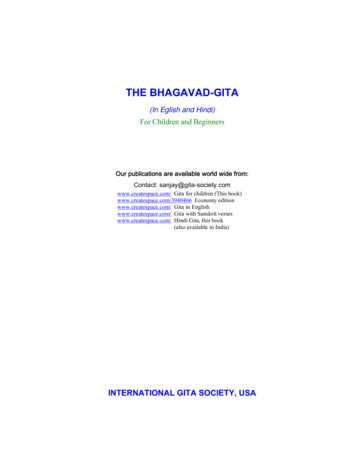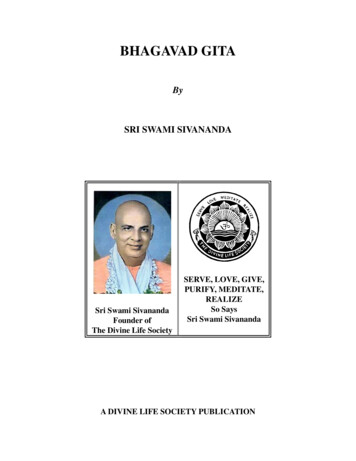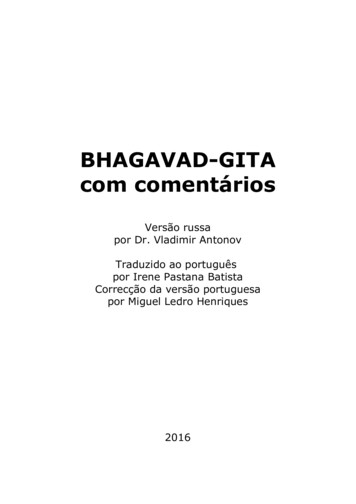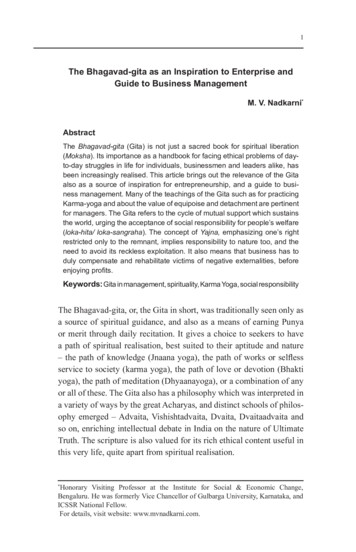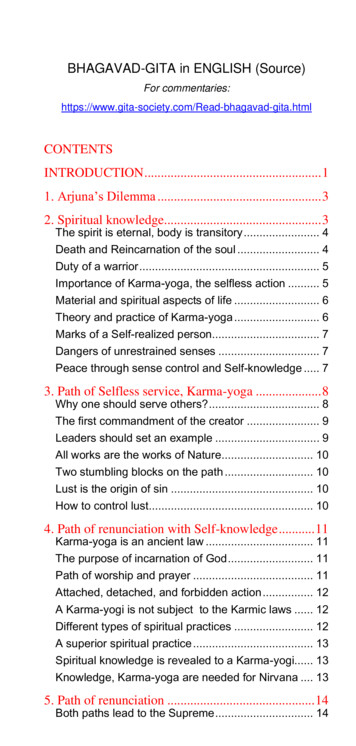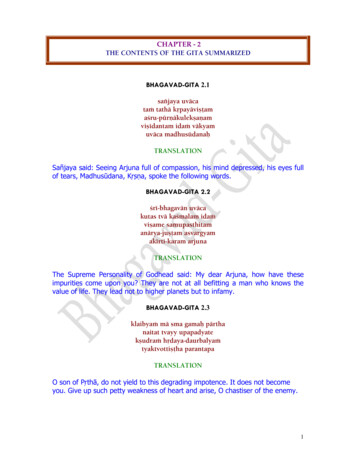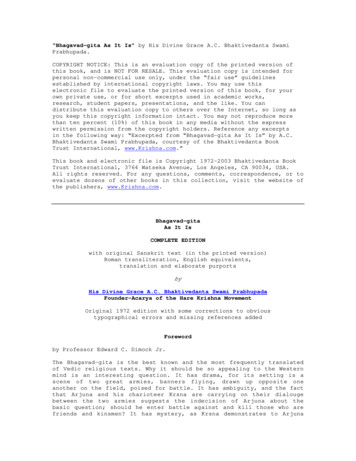
Transcription
Produced by the Department of EducationThe Theosophical Society in AmericaThe Bhagavad GitaA Study CourseBy John AlgeoAnalysis and commentary in 28 lessons 2000 The Theosophical Society in AmericaP.O. Box 270, Wheaton, Illinois 60189-0270
The Theosophical Society in AmericaThe Bhagavad GitaTHE BHAGAVAD GITA, Lesson 1A. Preface to the Bhagavad GitaThe Bhagavad Gita is one of the world’s most important books—indeed, one of the greatbooks of human culture, Eastern and Western alike.In India, the Gita is many things: it is the major guidebook to the spiritual life in theHindu tradition; it is an eirenicon—a work that harmonizes the diverse views of life that finda place within traditional Indic religious philosophy, and it is an inspirational and culturedefining book that is to Indian society what the gospels are to the West. It is hard to overstatethe importance and centrality of the Gita to Indian life.The Gita has been also, however, a powerful influence in the West. It is indeed part of aremarkable chain of links connecting East and West. The New England Transcendentalists—agroup of nineteenth-century Americans who were an important school of thinkers and writers,in a number of respects anticipating later Theosophical thought—read the first Englishtranslation of the Gita. Henry David Thoreau, one of that group, in particular wrote aboutreading the Gita on the shore of Walden Pond, and its philosophy inspired a famous essay ofhis, “On Civil Disobedience,” about how to cope with societal injustice. Much later, whenMohandas Gandhi was a young man and a law student in England, he was introduced to theGita by Theosophists, and then he read Thoreau’s essay, which in turn inspired his policy ofsatyagraha or passive resistance. Later Martin Luther King was in turn inspired by Gandhi’spolicy to create his own program of nonviolence. So the Gita has echoed back and forthacross the globe between India and America, as a defining document of contemporary thoughtand action. No other work has had a comparable influence across cultures in binding togetherEast and West.But what is the Gita in itself?The Gita is a poem (the word gita means “song”). It is a very small part of the greatestand longest epic ever written—the Mahabharata, which is far longer than the Greek Odysseyand Iliad combined. It recounts the story of a great civil war. Epics typically show the valuesand defining characteristics of a people. The Mahabharata is in that way the quintessentialstory of India. But it is also the story of all human beings, a universal epic, for it deals withfundamental human motives, frustrations, quandaries, and joys.The Gita deals with a basic theme in the Mahabharata—dharma or the way we should actbecause of who and what we are. In particular, the Gita is about a moral quandary in whichthe hero in the Mahabharata war faces fundamental questions about the right way to live. Thepoem operates on two levels—historical and archetypal. It is a history of an actual battlefought near modern Delhi at a turning point in human history. But it is also an archetypalmyth about the struggle that each one of us experiences within ourselves.The dual level of the poem is made clear in the opening two words of the poem:“Dharmakshetre, Kurukshetre,” which mean “On the field of dharma, on the Field of the 2000 The Theosophical Society in America2
The Bhagavad GitaThe Theosophical Society in AmericaKurus.” The Kurus were the ruling family of India at the time of the poem, and Kurukshetra isan actual geographical location, a field, near modern Delhi where the ancient civil war wasfought. So the second word of the poem tells us that we are dealing with a particular place andtime, millennia ago, in the heroic age of India, and half way around the globe from twentyfirst century America.But the first word of the poem tells us that we aredealing with a timeless reality. Dharma (a centralword in the poem) means, among other things, theessential nature of a thing or person. And so the poemis about the “field” or subject matter of what isessentially real in life. In reading the Gita, we cannotignore its historical setting, on the Field of the Kurus,but what is most important for all peopleseverywhere is what the poem has to say about thefield of dharma.The story centers on Prince Arjuna, the middle offive sons of the royal house (called Pandavas aftertheir father Pandu). Their father has died, leavingthem as wards of their uncle, who himself has ahundred sons. Arjuna’s cousins (called Kauravas—descendents of the ancient king Kuru), under theleadership of the eldest, the wicked Duryodhana,have plotted to cheat Arjuna and his brothers out oftheir legitimate inheritance and even to murder them.Arjuna, who belongs to the kshatriya or warrior caste, is called upon by his duty in life tofight against evil and for the right. He therefore is required by his social duties to defend hisbrothers’ legitimate claim to their kingdom against their usurping cousins. On the eve of thebattle, however, Arjuna experiences a crisis of conscience. On the one hand, he knows that hisduty as a kshatriya warrior compels him to defend his brothers’ rights; on the other hand,however, his duty to his family requires that he harm none of them, whatever they may be orhave done. And those he will be fighting include his cousins, his grandfather, and even histeacher, with whom the bond of support is even stronger than with blood relatives.Arjuna sees the terrible price to be paid for killing members of his own family. He seesno good coming from the battle and only evil from his own part in it. He therefore calls uponhis friend and charioteer, Shri Krishna, for advice. Krishna is a cousin of Arjuna’s and achildhood friend, but he is not merely human. Though Arjuna does not realize it at the start ofthe poem, Krishna is a divine incarnation—god made flesh. The Bhagavad Gita, which means“The Lord’s Song,” is Krishna’s answer to Arjuna’s desperation.The archetypal meaning of the poem is that within each of us a battle rages betweenselfish impulses that ignore the claims of justice and mercy and a realization that ultimatelywe are all connected in a unity that embraces all humanity and the whole world. Arjuna is our 2000 The Theosophical Society in America3
The Theosophical Society in AmericaThe Bhagavad Gitaconscious mind, which must make the choice of how we will live. The wicked cousins are ourimpulses to self-centeredness and greed. Krishna is the divine spark within us, our higher Self,which is always available to rein in the horses of our feelings and thoughts and to guide us inthe battle of life, if we will only seek that help.Arjuna’s quandary is a threefold one. Generalized to the common human situation, itsthree aspects can be formulated as follows:1. How can we act freely and unconditionedly?2. How can we have confidence in the power of goodness to make all things right?3. How can we choose between unclear alternatives to resolve the dilemmas we face?The message that Krishna, our higher Self, gives to Arjuna, our conscious mind, is athreefold one. First, in all our actions, we must be motivated to do what is truly right, not whatseems comfortable or convenient. That will give us the skill in action that we need and forwhich Karma Yoga (coming to wholeness by right action) is the answer.Second, if we act out of that motive and with a realization that a divine plan orders allthings in the world, the results of our actions will be good. That will give us the vision ofReality that we need and for which Bhakti Yoga (coming to wholeness by devotedconfidence) is the answer.Third, we can know what we should do—what is truly a right action for us—only if wefirst know ourselves—who we, in truth, are. We are not the selfish desires of the wickedcousins. We are not the confused and uncertain mind of Arjuna. As Arjuna discovers at theend of the poem, we are, in fact, ourselves Krishna, the divine spark, the higher Self. Thatgives us the knowledge that we need to choose between unclear alternatives and for whichJñana Yoga (coming to wholeness by direct insight into the nature of things) is the answer.The Gita is a song sung in the midst of a battle. It is a celebration of peace and harmonyin the midst of life’s confusion. It is a timeless assurance that we each have within ourselvesthe answers to all our questions and confusions. We need only call upon that inner power todiscover who we are, what we can trust, and how we should act.B. The Text of the PoemParticipants in this seminar may use whatever translation of the Gita they prefer. In fact itis good to use several translations at the same time—to compare how they express the ideas ofthe poem. There is an old Italian proverb: Traduttore, traditore “The translator is a traitor.”The play on words works better in Italian than in English, but the point of the proverb is that itis impossible to translate exactly the meanings, nuances, and associations of one language intoanother. So, in reading translations from another language, we are helped by using severaldifferent ones for the same text. Different translations will focus on different aspects of thesame words and so help to convey a better-rounded understanding of the original. 2000 The Theosophical Society in America4
The Theosophical Society in AmericaThe Bhagavad GitaIn these papers, quotations will generally be from, or based on, Annie Besant’stranslation of the Gita. There are several reasons for that choice. First, Besant’s translationstays very close to the original, so in it we get something like the literal meaning of theSanskrit Gita. Second, Besant was a great master of English style, so her translation readswell. Third, she was sensitive to the Theosophical meaning of the poem, so that also comesthrough well in her version. Occasionally, we will paraphrase Besant’s translation somewhatbecause it was first published in 1895, and so is in spots rather Victorian in style—particularlyin imitating the archaic language of old-style English scriptures (with words like thee andhath).If you use a literary translation, such as Sir Edwin Arnold’s poem, The Song Celestial, orSwami Prabhavananda and Christopher Isherwood’s very readable translation, The Song ofGod, be aware that they are much freer versions, often not corresponding verse by verse withthe original, but attempting to capture the general sense rather than the particular meanings. Avery useful scholarly version is Winthrop Sargent’s edition, The Bhagavad Gita (2nd ed.Albany: State University of New York Press, 1994), which gives an interlinear translation anda word-by-word gloss of the Sanskrit (in both devanagari and transliteration) and has a helpfulintroduction.C. ActivitiesChoose a translation (or several translations) of the poem to use for this seminar. Youmight go to a library or bookshop and browse through a number of translations, comparingthe same passages in several to find one that particularly appeals to you. If you are still indoubt—try Annie Besant’s.Skim over the translation(s) you choose to get a general sense of the poem, but don’tworry about details, which we will be considering later. Chapter one (which we will start nextmonth) is both difficult and untypical, so don’t get bogged down in or discouraged by it. It isa transition from the plot of the epic and uses a great many typical epic conventions. 2000 The Theosophical Society in America5
The Theosophical Society in AmericaThe Bhagavad GitaTHE BHAGAVAD GITA, Lesson 2A. OutlineThe treatment of each chapter or discourse in the Gita will begin with an outline of thatdiscourse to show its structure and identify its chief subjects. The numbers in parentheses areof the verses (or slokas) of that discourse.Discourse 1: The Despondency of ArjunaIntroduction: Transition from the epic contextSetting: The double location (1)Duryodhana’s concern and a catalog of participants (2–11)Exchange of challenges with a further catalog (12–19)The problem of the Gita: Arjuna’s crisisThe view from the center (20–25)Conflict of duty (26–37): Cause of despondencySocial consequences (38–44): Meaning of dharmaDilemma of selfish action vs. nonaction (45–47)B. CommentaryThe Gita is a small part of a large epic. It is mainly a conversation between Krishna andArjuna—although the conversation is rather one-sided since Krishna does most of the talking.And the conversation is held on the eve of a great battle. It is a song sung in the midst of astruggle, a harmony in discord.Discourse 1 does two things. First, it is a transition from the epic account of the battle to aphilosophical discourse about the nature of reality, the purpose of life, the terrible dilemmaswe all find ourselves in, and the means for resolving those dilemmas and achieving thepurpose of life. Epic conventions and themes are very prominent in this first discourse, butbecome much less so as the poem progresses.The first line of the poem tells us where we are—on the battlefield of the Kurus, but moreimportant, on the field of dharma—our destiny in life. And that is the second thing thatdiscourse 1 does. It establishes the problem that the protagonist, Arjuna, faces and to whichthe remaining seventeen discourses of the poem are the solution. His problem is one thatevery human being has to deal with, namely what choice to make when we are confronted bytwo options, both of which seem bad to us.The Greek philosopher Plato said that normally all human beings will do the right thing ifthey know what the right thing is. To do wrong is to harm oneself, to open oneself to pain.And since no person really wants to do that, when people actually do wrong, they have doneso because they did not know that what they were doing was wrong. They have acted, not outof a bad motive, but out of ignorance. Some Indic philosophers would have agreed with Plato,and so—as we shall eventually see—did the author of the Gita. 2000 The Theosophical Society in America6
The Theosophical Society in AmericaThe Bhagavad GitaArjuna is going to be confronted with a dilemma. He has to do something, but whateverhe might do seems wrong. He does not know what the right action is, and so he has lost theability to choose—to discriminate between alternatives. Arjuna’s problem is in fact a problemthat all of us share every day of our lives. Charlie Brown, in the “Peanuts” cartoon, oncecomplained that he had to take a test and had gotten ready for it, but he had prepared for atrue-false test, and it turned out to be multiple choice. That’s Arjuna, and that’s us. We expecta nice clear set of alternatives: right or wrong, true or false. But what we get are multiplechoice questions, and we don’t know how to choose.Let us now turn to the poem and see what Arjuna’s problem is.The first verse (or “sloka”) of the poem is spoken by the old, blind King Dhritarastra. Heis the father of the wicked Kaurava brothers, led by Duryodhana (whose name might besomewhat freely translated as “dirty fighter”). Duryodhana and his brothers have persecutedtheir cousins, the Pandavas, by stealing all their possessions, trying to murder them, anddriving them into exile. Dhritarastra knows that what his sons are doing is wrong—but theyare his sons and he does not have the clear-sightedness to correct them. In fact, he does nothave any sight at all. He is blind—both physically and morally. Because he cannot himselfsee, he asks his charioteer, Sanjaya, to tell him what is happening—what his “people” (hissons) and the Pandavas (Arjuna and his four brothers) are doing on the field of battle and onthe field of life.Because ancient warriors rode in chariots and needed their hands free to wield theirweapons, each warrior had a charioteer to handle the horses and guide the chariot. Thecharioteer did not fight himself, but merely observed the events of the battle and guided thechariot to the appropriate place on the field. (All of this readily lends itself to a moral orallegorical interpretation. For example, we can see the chariot as the body, the horses as thesenses, the warrior in the chariot as the mind or ego, and the charioteer as the higher self or“silent witness” within us.)Dhritarastra’s charioteer has the gift of clairvoyance, so he can tell the blind kingeverything that is happening. And the whole of the Gita after this first verse, in whichDhritarastra asks Sanjaya what is going on, is Sanjaya’s answer. The Gita has several levels ofreality and of discourse within it. First, there is the reality of the battle at Kurukshetra. Thenthere is the conversation between Dhritarastra (verse 1) and Sanjaya (the rest of the Gita)within that battle. Then there is the conversation between others, such as Arjuna and Krishna,which Sanjaya shortly begins to report. We have worlds within worlds in the Gita, just as wedo in life itself.In verse 2, Sanjaya begins to tell what is happening. He says that Duryodhana (the eldestof the wicked cousins) has looked at the army of the Pandavas and decided that they aredisturbingly strong. He is worried that they might win the battle, so he goes to talk with histeacher, Drona (who was also the teacher of the Pandavas in happier and more peaceful days).In verses 3–11, Duryodhana describes to his teacher the state of affairs as he sees it. Thisdescription is part of the transition from the epic style of the larger work, the Mahabharata.Epics all over the world include, as part of their technique, lists or catalogs—especially of 2000 The Theosophical Society in America7
The Theosophical Society in AmericaThe Bhagavad Gitanames of warriors. And these verses are such a conventional list of some of the chief warriorsin the battle.Duryodhana’s speech to his teacher leads up to an urging in verse 11 that, in view of thestrength of his cousins, the Pandavas, all his troops should do everything they can to guardBhisma. Bhisma is the grandfather of both the Kauravas and the Pandavas. As a young man,he made a heaven-shaking vow that included the promise always to support the ruler of theland and never to oppose that ruler. Because of his great virtue, the gods granted him the giftof choosing his own time and place of death. He is the most respected person in his entirefamily, so Duryodhana made him General of his army—an appointment Bhisma could notrefuse because of his vow. But Duryodhana is terrified that, if Bhisma is somehow killed, thePandavas will win the battle, so he wants the old Grandsire to be protected at all costs.To encourage his fearful grandson, and perhaps to shame him a bit as well, GrandfatherBhisma sounds a loud blast on his conch shell. The shell of the conch mollusk was used as ahorn; blowing into it produces an eerie deep-toned sound. Bhisma’s blast of the conch beginsa noise exchange between both armies of other conches, drums, horns—a tumultuous uproar.This sort of exchange was a conventional challenge to battle and a boast of prowess. Verses12–19 describe this exchange by cataloging the warriors and their conches (each of theinstruments having a name, just as weapons often do).In verses 20–23, Arjuna responds to the exchange of conch and other blasts of noise byasking his charioteer, Krishna, to take him to the center of the field so that he can survey thetwo armies about to fight. Several details in these verses are significant for the moralinterpretation of the poem. For example, Arjuna is said to have an ape as his crest. This helpsto identify the allegorical role Arjuna plays in the poem. He is the human mind, the monkeymind, not yet enlightened by gnosis or buddhi. He is you and me in our daily lives, jumpinghere and there, not focused.Arjuna invokes the highest in himself—his charioteer, Krishna—to “stay” his chariot “inthe midst, between the two armies.” The two armies represent the conflicting and strivingopposites of life. If we are to be engaged with them in their struggle, it may seem prudent toknow where we are, to behold the situation around us, to gaze on those with whom we mustcome to terms. But Arjuna has already had much experience with the warriors on both sidesand should know them all. His request to be quiet in the middle suggests an unwillingness tomake the difficult choice in circumstances requiring that a choice be made. The naming ofcharacters with a variety of epithets is another characteristic of all epics and often tells ussomething about the characters. In verse 24, Arjuna is called “Gudakesha,” which means“Lord of Sleep.” In Arjuna, buddhi (the faculty of being awake and of making right choices)is still asleep.There is, however, an irony about verses 20–23. We can look at them in two differentways. If Arjuna were awake, had the insight of buddhi active in him, knew how to choose—then to stay his chariot in the midst of conflicting forces would be the right way to act. Hewould then be in the middle of the field—not to find out what was going on—but to be at thestill point of the turning world. As it is, however, Arjuna does not want to act at all. He is 2000 The Theosophical Society in America8
The Bhagavad GitaThe Theosophical Society in Americanonplussed by the situation in which he finds himself, and does not know how to respond toit.When Krishna drives Arjuna’s chariot to the middle of the field, he says to the warrior(24–25), “O Partha, behold these Kurus gathered together,” or, as we might put it in morecontemporary idiom, “Well, Arjuna, just look at this family reunion!” And that remarkinitiates a crisis of conscience in poor Arjuna. He looks, and everywhere he sees relations andfriends (26–27). On one side, his brothers. But on the other side, his grandfather, his uncles,his cousins, and even his teacher. The bond between student and teacher was a sacred one—asstrong as, if not stronger than, blood ties. Now Arjuna’s crisis of conscience is to begin.[to be continued]C. ActivityThe poem is not quite as exotic as it might seem. Heroic societies all over the world andin all ages have been much the same—in ancient India, in classical Greece, in legendaryJapan, and in the inner cities of America. List the values to be found in such heroic societies.To what extent do those values still operate among us? Are they universals of humanbehavior? 2000 The Theosophical Society in America9
The Theosophical Society in AmericaThe Bhagavad GitaTHE BHAGAVAD GITA, Lesson 3A. OutlineArjuna’s dilemma has three aspects, each of which requires a different solution. Thethreefold dilemma is set forth in the last half of chapter 1. The numbers in parentheses are ofthe verses (or slokas).Discourse 1: The Despondency of Arjuna (continued)Family duty versus caste duty (28–39): Need for knowledge to chooseDestruction of the social order (40–44): Need for faith in final goodWithdrawal from all action (45–47): Need for skill in actionColophon: The nature of the GitaB. Commentary1. Family duty versus caste duty. When Arjuna looks around himself in the midst of thebattle, he thinks he has a conflict of duties (or dharmas). He is a kshatriya or warrior-ruler.His caste duty is to right wrongs, to defend the oppressed, to punish evil, to serve justice. Hisbrothers have been wronged and oppressed; his cousins have done evil and injustice. Arjuna’scaste duty is clear. But unhappily, those he must take action against are also his family—hiscousins, uncle, grandfather, and teachers. And there is a clear family duty never to harm one’srelatives, but always to help them.Arjuna is trapped between these two conflicting duties and does not know how to resolvethe conflict. He must discriminate, but is unable to do so. Discrimination is a faculty ofbuddhi, and buddhi (the principle of being awake) is asleep in Arjuna. Arjuna needsknowledge—not knowledge of facts, but knowledge of what is most important in life,knowledge that will let him make difficult choices correctly, knowledge to discriminatebetween alternatives. Arjuna articulates this personal dilemma in verses 28–39. To resolvethis dilemma Arjuna needs discriminative knowledge (jñāna) which comes from being awaketo the Truth (buddhi).All of us share Arjuna’s dilemma. We are Arjuna. Like him, we find ourselves facedthroughout life, not with a clear choice between good and evil (which would be easy tomake), but with a murky choice between partial goods and partial evils. Every day, we have todecide what we will do, what duties we will perform. And we need guidance in choosing.Part of the problem is that both Arjuna and we think of “duty” as something imposed onus from without. “Duty” is something we have to live up to. If we are told, “It is your duty todo this or that,” we do not usually respond with great joy. “Duty” implies a limitation on ourfreedom. It is something we have to do, whether we want to or not. But that is not what theSanskrit word dharma (often translated “duty” in English) really means. The basic meaning ofdharma is our essential core identity. Everything in the cosmos has its own dharma or uniquenature and purpose. To follow our dharma is to be genuinely and authentically ourselves. To 2000 The Theosophical Society in America10
The Bhagavad GitaThe Theosophical Society in Americafail our dharma is to be false to ourselves. To know what our dharma or duty in life is, wemust know who we are. That is one thing Arjuna must learn. And we also.2. Destruction of the social order. But Arjuna’s personal dilemma of choosing whether toviolate his caste duty or his family duty, which springs from his lack of knowledge of who hereally is, has a further implication. The family is the basis of the whole social order. If thefamily is destroyed or disrupted, so will be society as a whole. Arjuna understands that, and inverses 40–44 he articulates his fear over the future of society as a whole, which will beaffected—adversely as it seems to Arjuna—by the family feud in which he is engaged.In fact, Arjuna is right, or at least partly right. The great battle at Kurukshetra is going toresult in the destruction of the social order he has known. The Mahabharata marks the end ofthe heroic age of India and the beginning of the next period of Indian and human history. It isthe boundary between the heroic Bronze Age and our contemporary Iron Age or, as it is calledin Hindu chronology, the Kaliyuga. In Indian dice, kali is the one-spot; and to throw a kali isto lose the game—to crap out. So the Kaliyuga is the most degenerate era of history, thelosing time. Arjuna foresees that the onset of the Kaliyuga will result from the battle, and hehas no faith or confidence, as Tennyson expresses it in his poem In Memoriam:Oh yet we trust that somehow goodWill be the final goal of ill.All the news is not bad. We must pass through the Iron Age before a new and better GoldAge can start. The old game must end before the new one can begin. We must die to one lifebefore we can be reborn in another. Cycles, as Madame Blavatsky points out in the proem toThe Secret Doctrine, are the essence of existence. If we are paralyzed by fear of endings, wecan never experience new beginnings. What we, and Arjuna, need is the confidence in a finalgood outcome to life that comes from recognizing an intelligent governing order. The worldprocess is not accidental, but is guided by a plan that may be said to exist in the mind of God.If we devote ourselves to serving that plan, we will have the confidence we need to face thedownside of the cycles we experience. That is the second thing Arjuna must learn. And wealso.3. Withdrawal from all action. Faced with this double crisis, Arjuna has still a third one.Not knowing how to choose, having no faith that a divine providence is governing the world,Arjuna sees no way to act without karma ensnaring him in the effects of his action. And so heabandons himself to despair and tries to avoid taking any action (verses 45–47).Arjuna would rather give up his life (46) than do the wrong thing from the wrong motive(45). And so he abandons all action (47). Instead of standing upright in his chariot, he sinksdown on its seat—a position of inactivity. Arjuna does not know how to act rightly, and so hethinks he will not act at all. He lacks the skill to act with confidence and decisiveness. That isthe third thing Arjuna must learn. And we also.As it is, however, Arjuna casts aside his bow and arrow, which signifies his rejection ofhis dharma, his caste duty. But since the bow is also a symbol of the mind and the arrow ofthought intelligently directed, Arjuna’s casting them aside is also symbolic of the 2000 The Theosophical Society in America11
The Theosophical Society in AmericaThe Bhagavad Gitamindlessness and lack of intelligence in what he is doing. His mind is not buoyed up bydevotion, but overborne by grief. Thus he seeks relief in escape and abandon. This is Arjuna’sdark night of the soul, his utter despondency.The first discourse, like all the succeeding ones, ends with a colophon, which is in effectthe title of the discourse. All of the colophons follow the same pattern in their wording. Wewill consider the significance of this pattern later. For the present, it is enough to observe thateach of the discourses is called a Yoga, that is, a way of achieving wholeness withinourselves, between ourselves and others, and with the ultimate Reality that is the ground ofour being. And the first discourse is no exception. It too is a Yoga; for to achieve wholeness,we must first recognize that we are in a condition of fragmentation. To be buoyed up, we mustacknowledge our despondency.The first discourse is “The Despondency of Arjuna.” That is where Arjuna begins theprocess of learning. That is where we begin our upward journey. He and we will take thatjourney on the three paths (or margas): the path of knowledge of who we are and hence howto choose (jñāna marga), the path of devotion to the governing intelligence of the universe(bhakti marga), and the path of acting skillfully withou
THE BHAGAVAD GITA, Lesson 1 A. Preface to the Bhagavad Gita The Bhagavad Gita is one of the world’s most important books—indeed, one of the great books of human culture, Eastern and Western ali
